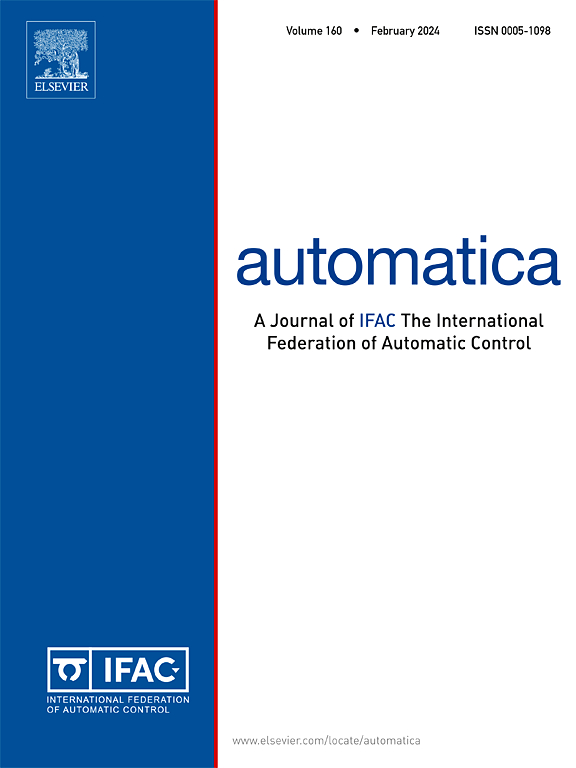Synchronous observer design for Inertial Navigation Systems with almost-global convergence
IF 5.9
2区 计算机科学
Q1 AUTOMATION & CONTROL SYSTEMS
引用次数: 0
Abstract
An Inertial Navigation System (INS) is a system that integrates acceleration and angular velocity readings from an Inertial Measurement Unit (IMU), along with other sensors such as Global Navigation Satellite Systems (GNSS) position, GNSS velocity, and magnetometer, to estimate the attitude, velocity, and position of a vehicle. This paper shows that the INS problem can be analysed using the automorphism group of the extended special Euclidean group : a group we term the extended similarity group . By exploiting this novel geometric framework, we propose a synchronous observer architecture; that is, an observer architecture for which the observer error is stationary if the correction terms are set to zero In turn, this enables us to derive a modular, or plug-and-play, observer design for INS that allows different sensors to be added or removed depending on what is available in the vehicle sensor suite. We prove both almost-global asymptotic and local exponential stability of the error dynamics for the common scenario of at least IMU and GNSS position. To the authors’ knowledge, this is the first non-linear observer design with almost global convergence guarantees or with plug-and-play modular capability. A simulation with extreme initial error demonstrates the almost-global robustness of the system. Real-world capability is demonstrated on data from a fixed-wing UAV, and the solution is compared to the state-of-the-art ArduPilot INS.
近全局收敛惯导系统的同步观测器设计
惯性导航系统(INS)是一个系统,它集成了惯性测量单元(IMU)的加速度和角速度读数,以及其他传感器,如全球导航卫星系统(GNSS)位置、GNSS速度和磁力计,以估计车辆的姿态、速度和位置。本文证明了利用扩展特殊欧几里得群SE2(3)的自同构群(我们称之为扩展相似群SIM2(3))来分析INS问题。利用这种新颖的几何框架,我们提出了一种同步观测器架构;也就是说,如果校正项设置为零,则观测器结构的观测器误差是平稳的。反过来,这使我们能够为INS导出模块化或即插即用的观测器设计,该设计允许根据车辆传感器套件中的可用内容添加或删除不同的传感器。对于IMU和GNSS位置的一般情况,我们证明了误差动力学的近全局渐近和局部指数稳定性。据作者所知,这是第一个具有几乎全局收敛保证或即插即用模块化能力的非线性观测器设计。在极端初始误差情况下的仿真结果表明,该系统具有几乎全局的鲁棒性。在固定翼无人机的数据上演示了实际能力,并将该解决方案与最先进的ArduPilot INS进行了比较。
本文章由计算机程序翻译,如有差异,请以英文原文为准。
求助全文
约1分钟内获得全文
求助全文
来源期刊

Automatica
工程技术-工程:电子与电气
CiteScore
10.70
自引率
7.80%
发文量
617
审稿时长
5 months
期刊介绍:
Automatica is a leading archival publication in the field of systems and control. The field encompasses today a broad set of areas and topics, and is thriving not only within itself but also in terms of its impact on other fields, such as communications, computers, biology, energy and economics. Since its inception in 1963, Automatica has kept abreast with the evolution of the field over the years, and has emerged as a leading publication driving the trends in the field.
After being founded in 1963, Automatica became a journal of the International Federation of Automatic Control (IFAC) in 1969. It features a characteristic blend of theoretical and applied papers of archival, lasting value, reporting cutting edge research results by authors across the globe. It features articles in distinct categories, including regular, brief and survey papers, technical communiqués, correspondence items, as well as reviews on published books of interest to the readership. It occasionally publishes special issues on emerging new topics or established mature topics of interest to a broad audience.
Automatica solicits original high-quality contributions in all the categories listed above, and in all areas of systems and control interpreted in a broad sense and evolving constantly. They may be submitted directly to a subject editor or to the Editor-in-Chief if not sure about the subject area. Editorial procedures in place assure careful, fair, and prompt handling of all submitted articles. Accepted papers appear in the journal in the shortest time feasible given production time constraints.
 求助内容:
求助内容: 应助结果提醒方式:
应助结果提醒方式:


